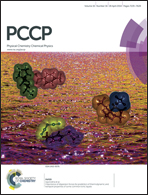Non-hydroxyl radical mediated photochemical processes for dye degradation†
Abstract
Using solar energy for the decontamination of wastewater is a promising solution to the water-energy nexus. Current advanced oxidation processes have an unsatisfactory efficiency in the treatment of dye wastewater due to the non-selectivity of hydroxyl radicals. More efficient photochemical approaches for dye degradation are highly needed. Three diketones, biacetyl, acetylacetone, and acetonylacetone, were proven to be potent activators for the photodecoloration of azo, triarylmethane and anthraquinone dyes. The photodegradation kinetics of Acid Orange 7 in the UV/diketone processes was much faster than that in the UV/H2O2 system. Photo-induced energy and electron transfer were possible mechanisms for dye degradation in the diketone systems. Adducts of dye and acetylacetone were identified, indicating a unique dye degradation route through adduct formation and decomposition. Unlike acting only as the target substrate of ˙OH in advanced oxidation processes, the dyes played vital roles in the UV/diketone processes. The findings here provide new insights for designing more efficient technologies for environmental remediation, based on diketone photochemistry.


 Please wait while we load your content...
Please wait while we load your content...